|
|
the British "Spitfire" |
the German Messerschmitt "BF-109" |
After Wilbur and Orville (1940 - present time)
At the outbreak of World War II, Germany and Great Britain possessed bombers capable of flying 400 km/h and fighters capable of flying nearly 600 km/h. See the famous two:
|
|
the British "Spitfire" |
the German Messerschmitt "BF-109" |
During WWII the development of the aeroplane again makes a giant leap and again war is the direct cause. Aeroplanes are becoming faster, bigger and heavier. The British Vickers Supermarine Spitfire and the Hawker Hurricane defend their country in "The Battle of Britain" against German Messerschmitts. These are all fighters. German Heinkel bombers drop bombs on London and other cities. Very soon British bombers like the Bristol Blenheim, AVRO Lancaster and Handley Page Halifax and later on the American Boeing B-17s bomb German plants and cities. Many aeroplanes were lost, but many more are built. In this war too ten thousands of aeroplanes are built.
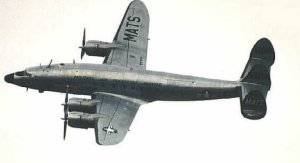 Some
airliners, already "on the drawing table" will become transport
aircraft for the war effort. The Lockheed Constellation (left) and the
Douglas DC-4. There is a great demand for transport aircraft during the war.
After the war, these are the aeroplanes with which the airlines start their
scheduled services. Just modified military aircraft.
Some
airliners, already "on the drawing table" will become transport
aircraft for the war effort. The Lockheed Constellation (left) and the
Douglas DC-4. There is a great demand for transport aircraft during the war.
After the war, these are the aeroplanes with which the airlines start their
scheduled services. Just modified military aircraft.
WWII also shows the first usable helicopter flying. It's a Sikorsky and it flies already in 1940.
An important development is the jet engine. Until the arrival of the jet engine all engines were piston engines that work exactly like a car engine (although much more complicated...). They use petrol (gasoline) as a fuel and have pistons that are going up and down. Piston engines for aviation are strong and lightweight. That's why they look different. These engines move propellers to move the aeroplane forward. The speed limit for aircraft with piston engines and propellers is around 700 km/h. The jet engine is something completely new. Actually it does not possess a propeller, but sucks in air, which leaves the other end of the engine red-hot because fuel is added to the air. Of course the fuel is ignited. In the Technology part you can learn more about jet engines.
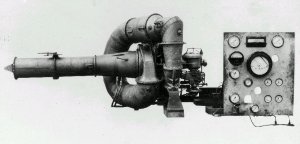 |
 |
| Sir Frank Whittle's first jet engine | And this is his third |
Germany and Britain designed jet engines even just before. Whittle is the first in the world to run his engine, but Hans von Ohain's engine is the first to fly. The British engines, built by Rolls Royce are better. This company still builds state-of-the-art jet engines. At the end of WWII both countries bring jet fighters into action. Germany the Messerschmitt 262 and Britain the Gloster Meteor.
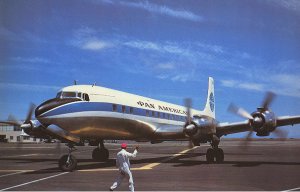 After
the war civil aviation is getting back to normal. The airliners still use piston
engines because they are more economic to run. Jet engines use a lot of fuel and are very
noisy. KLM purchases the beautiful Constellation and later on the Super Constellation,
DC-6 and the beautiful DC-7C (Seven Seas, left).
After
the war civil aviation is getting back to normal. The airliners still use piston
engines because they are more economic to run. Jet engines use a lot of fuel and are very
noisy. KLM purchases the beautiful Constellation and later on the Super Constellation,
DC-6 and the beautiful DC-7C (Seven Seas, left).
The US Airforce purchases the big eight-engine B-52 bomber. They still fly.
The first jet airliner is the beautiful streamlined
British De
Havilland Comet. Her maiden flight is in 1952. She is fast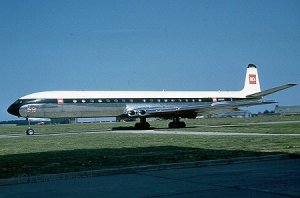 and (to the passengers) quiet.
But unfortunately soon accidents happen. Something new is threatening aviation: metal
fatigue. What had happened? The hull of the jet aeroplanes are filled with
compressed air because they fly at high altitudes at which people cannot
breath very well. These compressions cause the hull to expand a little. If this
happens over and over, cracks can appear. That is exactly what happened. The
cracks grew larger until a fatal catastrophe followed. The research that followed
was to the benefit of all later jet airliners because of the lessons learned.
and (to the passengers) quiet.
But unfortunately soon accidents happen. Something new is threatening aviation: metal
fatigue. What had happened? The hull of the jet aeroplanes are filled with
compressed air because they fly at high altitudes at which people cannot
breath very well. These compressions cause the hull to expand a little. If this
happens over and over, cracks can appear. That is exactly what happened. The
cracks grew larger until a fatal catastrophe followed. The research that followed
was to the benefit of all later jet airliners because of the lessons learned.
At the right you can see the Comet 4. There was nothing wrong with that. Later
on some were converted to the RAF Nimrod Early Warning aeroplanes.
In the meantime Boeing starts building the 707, a jet airliner. Boeing has learned from the Comet disaster. Other companies follow. Douglas builds the DC-8. Jet engines have become less fuel thirsty and jet aircraft are here to stay.
Aircraft like the Super Constellation and the DC-7 can't grow bigger because the piston engine development is at its end. All the iconic aircraft are being scrapped from 1961 on. A pity, but nobody took care in those days.
Passengers choose the jet airliner because they are quieter inside and faster. A trip Amsterdam - New York takes only seven hours, compared with the 14 hours of Constellation's voyage.
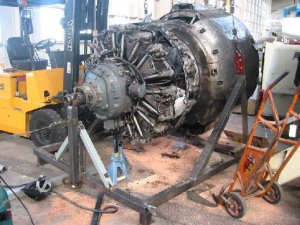 |
 |
| Constellation piston engine | Modern jet engine |
The piston engine had come at the end of the
development. The jet engine on the contrary, can be engineered stronger and stronger. At a thrust
of 115.000 lb (52.000 kg) the General Electric GE 90 is the most powerful jet
engine at the moment. It can grow even more powerful. Just because there is no
need for a stronger engine at the moment, it will stay at this thrust for a
while. The GE 90 engine is about 2,5 times more powerful than the engine the Boeing
747 Jumbo Jet used in 1969.
That year shows two ways of thinking about civil aviation. The Americans build
the Boeing 747, a big aeroplane capable of transporting 500 passengers at a
speed of 900 km/h.
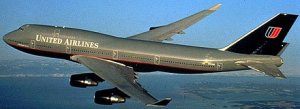 |
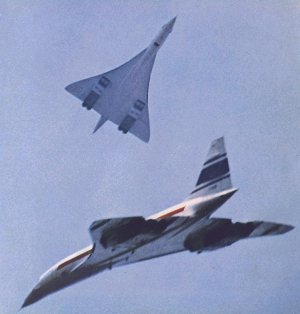 |
| Boeing 747-400 "Jumbo jet" | Two Concordes at an airshow |
Europe thinks in a different way: in 1969 the Anglo/French Concord makes it's maiden flight. It can fly as fast as 2300 km/h. Only 16 are built. Boeing has built in excess of 1500 747 aircraft. Flying fast with Concorde is much more expensive that flying slower in the 747. For further reading: Concordes last flight.
Progress in aviation is not very striking anymore, at first sight. It is a matter of small steps. Most gauges and dials have been replaced by flat screens. Computers do most of the work. In fact, aircraft can fly without the pilot, but they are there, just in case.....
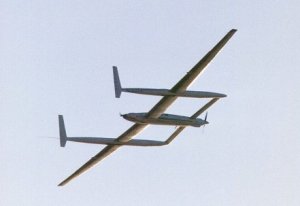 Another
development is the application of lighter and stronger materials, for instance
strong carbon material. It is used on the Voyager, which flew non-stop
around the world in 1986. It covered a distance of 35.000 km. (How come? The circumference
of the equator is 40.000 km. Think about it!).
Another
development is the application of lighter and stronger materials, for instance
strong carbon material. It is used on the Voyager, which flew non-stop
around the world in 1986. It covered a distance of 35.000 km. (How come? The circumference
of the equator is 40.000 km. Think about it!).
The brand new Boeing 787 is for a major part built from carbon fibre materials.
Jet engines are so reliable that aeroplanes like the Boeing 777 fly the oceans on only two engines!
These pages only tell a small part of the history of aviation. I left out a tremendous part of it. If you want to know more, look in the local library or visit the Internet. This website contains a part with links to information and the the Technology page might be of interest to you.